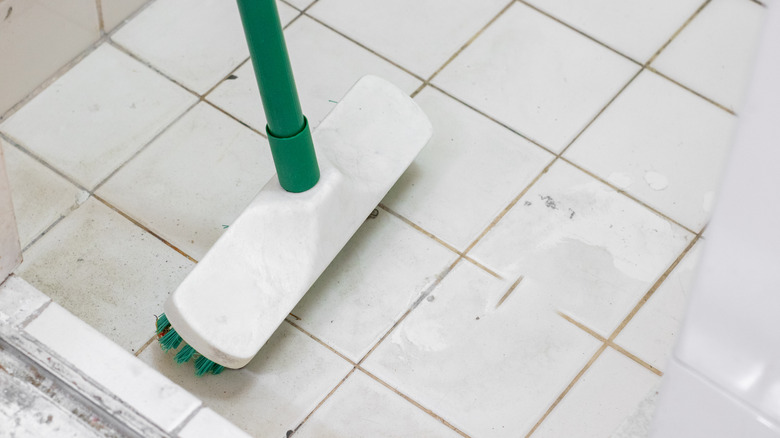Why Cleaning Your Grout With Baking Soda May Not Be The Best Idea
Out of all the nooks and crannies you have around your home, grout is one of the most challenging places to keep clean. The space between tiles is easily susceptible to food, shampoo, and liquids getting stuck when the grout isn't adequately sealed. The surface easily stains, making it challenging to clean. While there are many easy ways to clean grout with homemade solutions, baking soda is one of the ingredients homeowners tend to grab first to clean it. However, baking soda isn't the ideal solution for making your grout sparkle and look brand new. It can wear down the grout and damage the tile surrounding it.
Baking soda is a combination of soda ash and carbon dioxide, and it's commonly manufactured. However, it is naturally occurring in a handful of locations, including the Green River Basin in Wyoming, where the trona ore mineral is mined to make baking soda (via Meliora Cleaning Products). It's known to remove stubborn stains and deodorize smells, especially in the most unexpected ways, since it's an absorbing ingredient. When baking soda is mixed with water, it helps to cut through dirt and grease stains, but when applied to grout, it breaks down the material. Grout needs to be kept in perfect condition to keep the tiles intact.
The grout will end up discolored and stained
When cleaning grout with baking soda, it's not usually used alone. It's typically mixed with vinegar and lemon, creating a highly acidic mixture that can cause the grout to soften over time and make the tiles weak. Technical director at natural stone and tile cleaning and aftercare product supplier LTP, Mark Atkins, claims, "A lot of natural materials, like limestone and marble, are very sensitive to acid and alkaline, as are grout joints. All of these can damage the natural tile and grout joint," per Express.co.uk. Using highly acidic cleaners on grout will cause discoloration, especially if it's porous, like cement grout. If the baking soda is applied repeatedly onto a sealed grout surface, it will remove the sealant and penetrate deep into the grout, staining it.
In addition, when baking soda is mixed with another cleaning ingredient, like hydrogen peroxide, it never completely combines. So, when you apply the solution to the grout, it leaves the surface with a white layer of baking soda. You can use hydrogen peroxide instead of combining it with baking soda, which will remove dirt and stains much better. Hydrogen peroxide won't damage the grout or tiles but avoid using it on marble surfaces. You can apply it with a toothbrush or a spray bottle to clean the grout efficiently.

